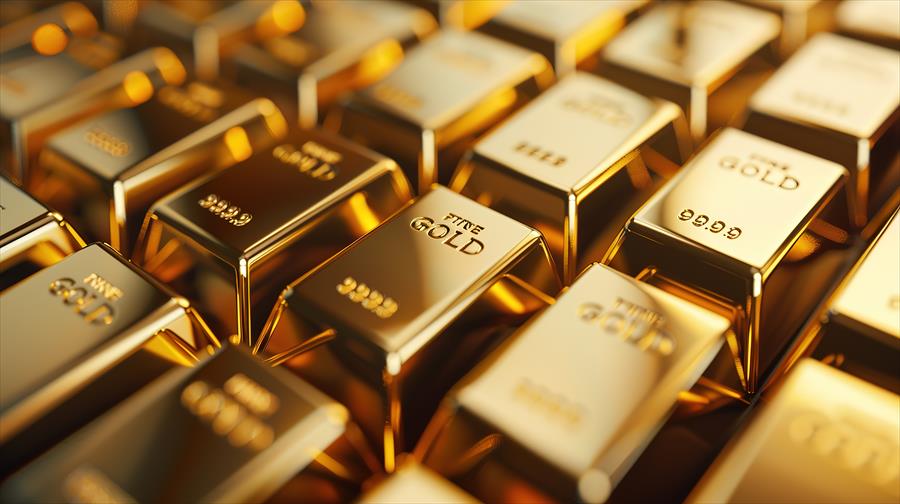The Truth behind Gold Bricks: Purity, Value, & Misconceptions
When we think of gold bricks, images of Fort Knox or bank vaults filled with gleaming yellow bars often come to mind. These iconic symbols of wealth and security have captivated our imaginations for centuries. But have you ever wondered if gold bricks are really pure gold? In this comprehensive guide, the precious metals experts from First National Bullion, the best place to buy gold in Carlsbad, delve into the fascinating world of gold bricks, exploring their composition, production process, and the factors that determine their purity and value.
Before we dive into the purity question, let’s establish what we mean by “gold bricks.” Gold bricks, also known as gold bars or ingots, are large, standardized units of gold used for storage, investment, and trading. They come in various sizes, with the most common being the 400-troy-ounce “Good Delivery” bar used in international markets.
The Purity Question
Are gold bricks 100 percent pure gold? The short answer is not always. While it’s possible to create gold bricks of extremely high purity, most gold bricks aren’t 100 percent pure gold. Here’s why:
Technical Limitations
Achieving absolute purity in gold is technically challenging and economically impractical on a large scale. Even the most refined gold typically contains trace amounts of other elements.
Standardization & Practicality
Most gold bricks are produced to meet specific purity standards that balance purity with practicality and cost-effectiveness. The most common purity levels for gold bricks are:
- 99.5 percent pure (often called 995 fine)
- 99.99 percent pure (9999 fine)
- 99.999 percent pure (99999 fine)
Intentional Alloying
In some cases, small amounts of other metals are intentionally added to gold to improve its physical properties, such as hardness and durability. Common metals used in gold alloys include:
- Copper – Adds a reddish hue and increases strength
- Silver – Adds a whitish hue and improves malleability
- Zinc – Used to deoxidize the alloy and improve castability
The Gold Purity Scale: Karats & Fineness
To understand gold purity, it’s essential to familiarize yourself with two key measurements:
Karats
The karat system measures gold purity on a scale of 0 to 24, with 24 karats representing pure gold. Most gold bricks are 24 karat or very close to it.
Fineness
Fineness expresses gold purity as parts per thousand. For example:
- 999.9 fine = 99.99 percent pure gold
- 995 fine = 99.5 percent pure gold
Hallmarking & Certification
To guarantee the purity of a gold brick, hallmarking and certification are essential. A hallmark is an official mark or series of marks struck on items made of precious metals, including gold, to certify their content and purity. Hallmarks typically include:
- Assay office mark – Identifies the assay office that tested the gold
- Fineness mark – Indicates the purity of the gold (e.g., 999 for 99.9 percent purity)
- Manufacturer’s mark – Identifies the producer of the gold bar
These hallmarks provide transparency and assurance to buyers and investors, helping to prevent fraud and ensure the quality of gold products.
Production Process: How Gold Bricks Are Made
The journey from raw gold to a polished brick involves several steps:
- Mining and extraction – Gold is mined from the earth through various methods, including open-pit mining and underground mining.
- Refining – The extracted gold undergoes a refining process to remove impurities and increase its purity. This may involve chemical treatments, electrolysis, or other advanced techniques.
- Melting and casting – The refined gold is melted and poured into molds to create the desired brick shape and size.
- Cooling and finishing – Once cooled, the gold bricks are removed from the molds and may undergo additional finishing processes, such as polishing or stamping with identifying marks.
Factors Affecting Gold Brick Purity
Several factors influence the final purity of gold bricks:
- Source material – The initial purity of the gold ore or recycled gold can affect the final product’s purity.
- Refining technology – Advanced refining techniques can achieve higher levels of purity but may be more expensive.
- Intended use – Gold bricks for industrial applications may have different purity requirements than those for investment purposes.
- Market demand – Consumer preferences and industry standards can influence the target purity levels for gold bricks.
Factors Affecting Gold Bar Value
Several factors can influence the value of a gold bar, including:
- Purity – Higher purity gold bars command higher prices.
- Weight – Gold bars are priced based on their weight in troy ounces.
- Brand – Recognized brands with a reputation for quality can be more valuable.
- Condition – Bars in pristine condition with intact hallmarks and certifications are more valuable.
Investors should consider these factors when purchasing gold bars to ensure they’re making a sound investment.
How to Ensure the Purity of Your Gold Brick
Ensuring the purity of your gold brick involves due diligence and verification. Here are some steps to take:
Buy from Reputable Dealers
Purchasing gold bars from reputable dealers with a track record of integrity can significantly reduce the risk of buying impure gold. Look for dealers who are members of recognized industry associations and who provide detailed documentation and certification for their products.
Verify Hallmarks & Certifications
Always check the hallmarks and certifications on the gold bar. Ensure the fineness mark aligns with the advertised purity and that the assay office and manufacturer’s marks are from reputable entities.
Conduct Independent Testing
For added assurance, consider having your gold bars independently tested by a professional assay office. These tests can verify the purity and composition of your gold, providing peace of mind that you’re getting what you paid for.
The Future of Gold Bricks: Trends & Innovations
As technology advances, we may see changes in gold brick production and standards:
- Increased purity – New refining techniques may make ultra-high-purity gold more accessible.
- Blockchain integration – Some companies are exploring ways to use blockchain technology to track and verify gold bricks.
- Sustainable production – There’s growing interest in ethically sourced and environmentally friendly gold production methods.
While gold bricks may not always be 100 percent pure gold, they remain a symbol of wealth and a popular investment vehicle. Understanding the nuances of gold brick purity, production, and value can help you make informed decisions, whether you’re an investor, a collector, or simply curious about these iconic symbols of prosperity. Remember, in the world of gold bricks, purity is important, but it’s not the only factor that matters.
Whether they’re looking to buy or sell gold bars, platinum coins, or silver bullion, Carlsbad residents trust the reputable dealers at First National Bullion and Coin. You can rely on our experienced professionals when you’re looking to add precious metals to your collection or investment portfolio. Call one of our precious metals experts today.
The statements made in this blog are opinions, and past performance is not indicative of future returns. Precious metals, like all investments, carry risk. Precious metals and coins may appreciate, depreciate, or stay the same in cash value depending on a variety of factors. First National Bullion does not guarantee, and its website and employees make no representation, that any metals for sale will appreciate sufficiently to earn the customers a profit. The decision to buy, sell, or borrow precious metals and which precious metals to purchase, borrow, or sell are made at the customer’s sole discretion.


